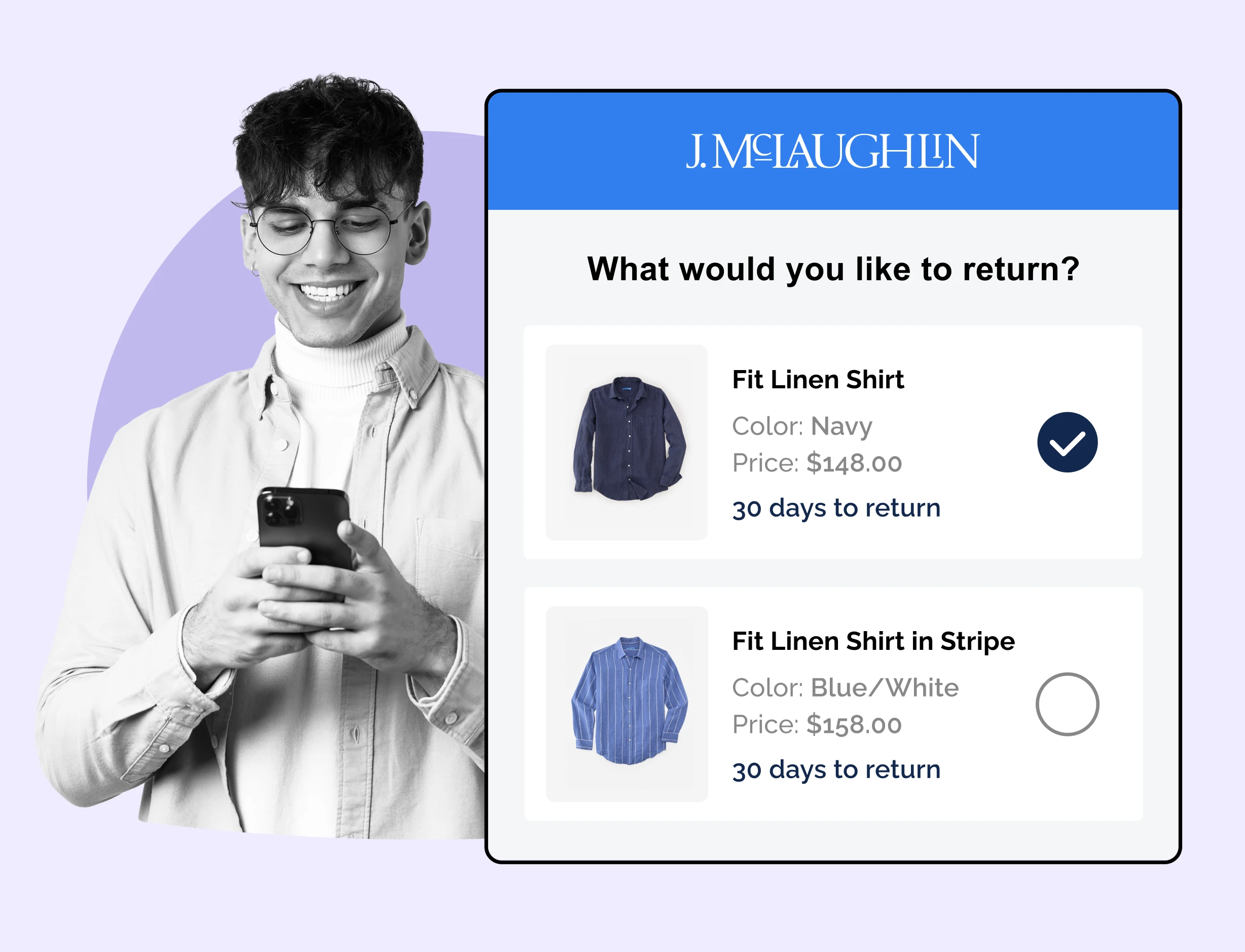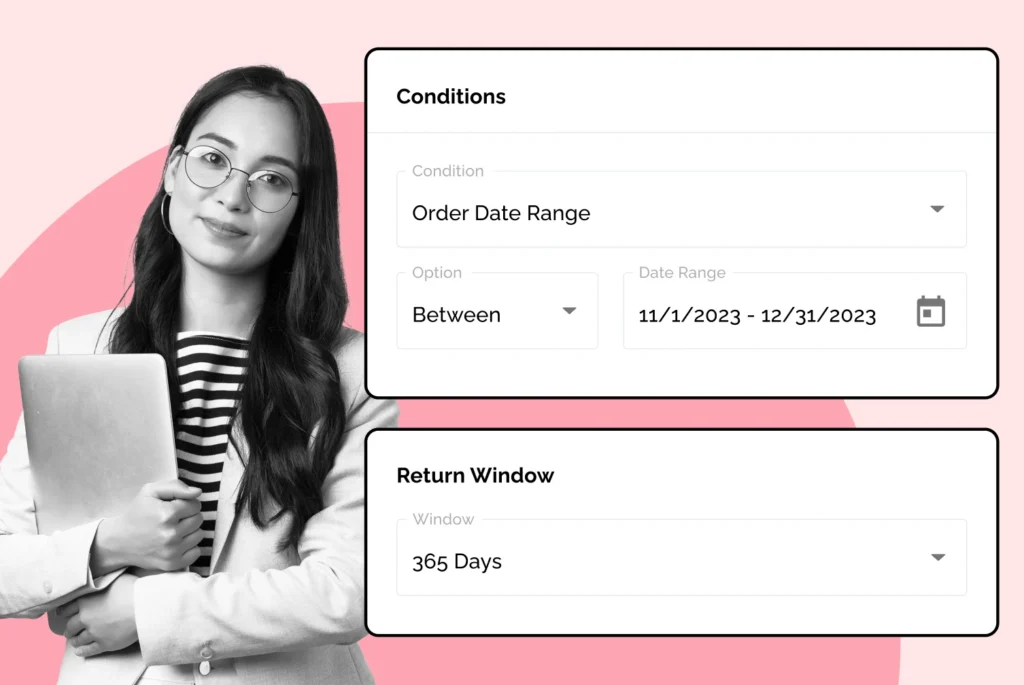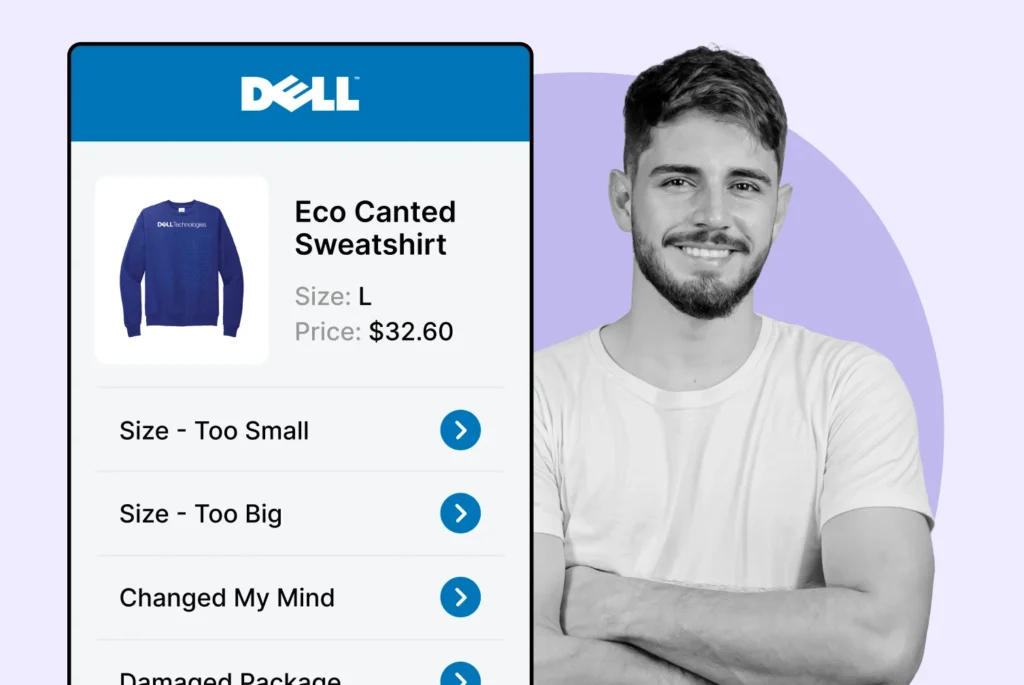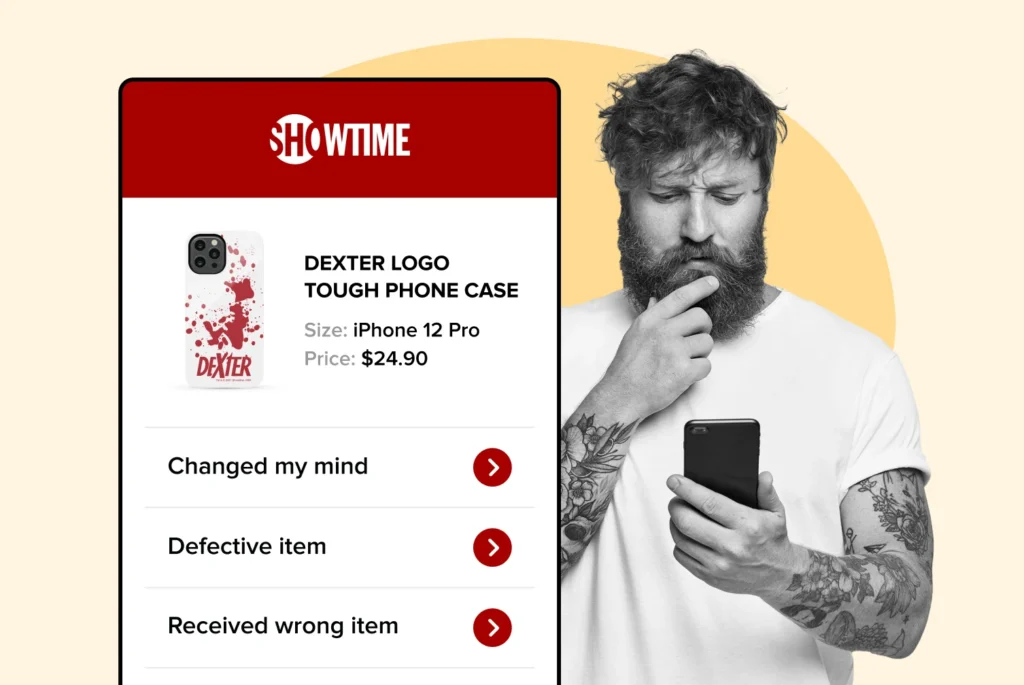
How to Make Your Return Policy a Powerful Marketing Asset
This article will show you how to make your return policy a key part of your marketing strategy, driving your business to long-term success!
Shipping, Tracking & Notifications
Boost customer experience and reduce support tickets
Realtime order and shipment tracking
Proactive order and shipping notifications
AI-Enhanced Discounted Labels
Predictive pre-purchase estimated delivery dates
Self-Serivce branded order tracking
Effortless experience delivered
Identify and Resolve Order Issues
Realtime order and shipment tracking
Make returns profitable and delight customers
Flexibility to define any return destinations & conditions
Simplify returns for your customers and team
Incentivize exchanges over returns
Returns management made easy for your team
Returns management made easy for your team
Easy claims and smart upsells
Understand why your customers are returning
In-Store & Curbside Pickup
Unify the online and the in-store experience
Hassle-free pickup experience for customers
In-Store dashboard to keep operations streamlined
In-Store and Online orders unified
Drive foot-traffic to your stores
Shipping, Tracking & Notifications
Boost customer experience and reduce support tickets
Realtime order and shipment tracking
Proactive order and shipping notifications
AI-Enhanced Discounted Labels
Predictive pre-purchase estimated delivery dates
Self-Serivce branded order tracking
Effortless experience delivered
Identify and Resolve Order Issues
Realtime order and shipment tracking
Make returns profitable and delight customers
Flexibility to define any return destinations & conditions
Simplify returns for your customers and team
Incentivize exchanges over returns
Returns management made easy for your team
Returns management made easy for your team
Understand why your customers are returning
In-Store & Curbside Pickup
Unify the online and the in-store experience
Hassle-free pickup experience for customers
In-Store Dashboard to keep operations streamlined
In-Store and Online orders unified
Drive foot-traffic to your stores
Boost customer experience and reduce support tickets
Realtime order and shipment tracking
Proactive order and shipping notifications
AI-Enhanced Discounted Labels
Predictive pre-purchase estimated delivery dates
Self-Serivce branded order tracking
Effortless experience delivered
Make returns profitable and delight customers
Flexibility to define any return destinations & conditions
Simplify returns for your customers and team
Incentivize exchanges over returns
Returns management made easy for your team
Equip your team for precise return checks.
Easy claims and smart upsells
Understand why your customers are returning
Unify the online and the in-store experience
Hassle-free pickup experience for customers
In-Store Dashboard to keep operations streamlined
In-Store and Online orders unified
Drive foot-traffic to your stores
Find the answer to all your questions
Take a step by step trip through our functionality to see how we can improve your ecommerce processes.
Explore the most comon questions about WeSupply
Calculate the ROI that WeSupply can bring you
Read actionable articles on how to optimize your post-purchase experience and decrease support tickets
Get inspired by stories of how our customers implemented an effortless post-purchase experience
Wondering if WeSupply is a good fit for you? Read through our use cases to see how we can help you increase conversion & improve CX!
A Deep Dive into Top Companies' Order Tracking & Returns Strategy
Find the answer to all your questions
Explore the most comon questions about WeSupply
Calculate the ROI that WeSupply can bring you
Request a no strings attached review of your current shopping experience and missed conversion opportunities
Take a step by step trip through our functionality to see how we can improve your ecommerce processes.
Read actionable articles on how to optimize your post-purchase experience and decrease support tickets
Get inspired by stories of how our customers implemented an effortless post-purchase experience
A Deep Dive into Top Companies' Order Tracking & Returns Strategy
Wondering if WeSupply is a good fit for you? Read through our use cases to see how we can help you increase conversion & improve CX!

Need to create your clothing refund policy? This guide will explain how to draft a clear and fair policy to manage returns and build trust with your customers. You’ll learn about setting return windows, conditions for returns, and handling return shipping costs, ensuring a smooth returns process for your clothing business.
A clear and well-structured clothing refund policy is essential for managing high return rates and building customer trust.
Key elements of an effective refund policy include defined return windows, conditions for returns, and clarity on shipping costs, which all enhance customer satisfaction.
Implementing customer-friendly practices, such as promoting exchanges and incorporating sustainable methods, can lead to increased loyalty and long-term revenue growth.
WeSupply streamlines clothing refund policies with clear return windows, flexible exchanges, and automated management of non-returnable items. It controls shipping costs, offers transparent policies, and supports sustainable practices. Get started with WeSupply Today!
In the world of online retail, particularly in the apparel sector, having a clear and well-structured refund policy is more than just a formality—it’s a necessity. Clothing accounts for a significant portion of online purchases, and with it comes a unique set of challenges, primarily due to high return rates. A robust return and refund policy informs customers about what to expect and sets clear guidelines, making the return process smoother for both parties.
A well-defined return policy doesn’t just handle customer returns; it builds customer trust and loyalty. When customers know they can return items easily and without hassle, they’re more likely to make a purchase in the first place. This sense of security can turn one-time buyers into loyal, repeat customers who feel confident shopping with your brand again and again.
Let’s examine why return rates are especially high in apparel e-commerce and the influence of transparent return policies on customer trust and loyalty.
The apparel e-commerce sector is notorious for its high return rates, with figures reaching as high as 26%, and in some cases, even 40-50%. This is largely due to the subjective nature of fashion purchases, where personal preferences and body image play significant roles. The practice of ‘bracketing’—buying multiple sizes or colors with the intent of returning most—especially among Gen Z consumers, further fuels this trend. As a result, having a clear and detailed return and refund policy is essential for managing these high return rates effectively.
The reasons behind these returns vary, from impulse purchases that don’t meet expectations to inaccurate sizing and product descriptions. Additionally, subjective preferences related to body image and self-esteem often lead to higher return rates.
Retailers can tackle these challenges by clearly detailing their return policies, covering aspects from return windows to conditions for returns. This approach manages customer expectations and reduces the impact of high return rates on the business.
A transparent return policy greatly influences customer trust. This, in turn, fosters customer loyalty. Studies indicate that 91% of consumers feel that an easy return process influences their decision to shop with a retailer again. When customers understand the return and refund policies clearly, it builds trust and encourages them to make purchases, knowing they can return items if necessary without hassle. This trust translates into repeat business and long-term customer loyalty.
Moreover, a seamless return process does not only enhance customer satisfaction but also positively influences their overall shopping experience. Negative return experiences, on the other hand, can lead to lost sales and damage a brand’s reputation.
Thus, a thoughtfully designed return policy is vital for nurturing customer loyalty and securing long-term business success in the competitive e-commerce landscape.
Creating an effective clothing refund policy involves more than just stating that returns are accepted. It requires a detailed outline of various components that influence customer decisions. A well-structured refund policy helps in building customer trust and setting clear expectations for both customers and the business. Key elements include defining return windows, specifying conditions for returns, and clarifying return shipping costs.
These components are crucial as they directly affect how customers perceive the return process. For instance, clear return windows help customers understand the time frame within which they can return an item, while specific conditions for returns ensure that items are returned in a sellable condition. Additionally, clarity on who bears the return shipping costs can significantly influence a customer’s purchasing decision.
We will now examine each of these elements in detail.
Establishing clear return windows is fundamental to an effective return policy. Typically, a 30-day return window is considered fair by most shoppers, but this can vary depending on the type of merchandise. Retailers have the discretion to set these timeframes, which can range from 10 to 60 days. Establishing a definitive timeframe for returns aligns with customers’ shopping habits and significantly improves satisfaction.
Moreover, offering extended return windows can provide added flexibility, particularly during peak shopping seasons like holidays. This approach not only enhances customer satisfaction but also builds loyalty by accommodating customers who may need more time to decide on their purchases.
It’s crucial to communicate these timeframes clearly and make them visible across your website’s various touchpoints.
WeSupply simplifies the management of return windows with tailored solutions to reduce confusion and enhance customer satisfaction.
Brand/Vendor-Specific Timelines: Customize return windows for different brands, maintaining control while accommodating diverse needs.
Extended Holiday Returns: Offer longer return periods during holiday seasons to improve the shopping experience and meet customer expectations.
WeSupply’s flexible approach to return windows ensures clarity and satisfaction, enhancing both customer experience and loyalty. Discover how WeSupply’s other pre-built return policies can further streamline your return processes and boost customer satisfaction.
When creating a return policy, specifying the conditions for returns, especially for hygiene-sensitive products, is important. For instance, items like underwear and swimwear typically have stricter return conditions due to hygiene concerns and are often non-refundable. Differentiating return policies based on product categories ensures safety and compliance while protecting business interests.
Requiring items to be in their original packaging for refunds helps maintain product integrity and reduces disputes. Clearly stating which items are non-refundable and under what conditions they can be returned builds customer trust and helps manage expectations. This transparency is essential for reducing misunderstandings and fostering a positive shopping experience.
WeSupply streamlines the management of return conditions by clearly defining item categories and hygiene considerations.
Specifying who covers return shipping costs is a vital part of any return policy. Transparency regarding these costs helps manage customer expectations and can influence their purchase decisions. Typically, customers are responsible for return shipping costs in cases of a change of mind, while retailers may cover these costs if the return is due to defects or mistakes.
Offering free return shipping can significantly enhance the customer experience and encourage purchases. To balance customer satisfaction with cost management, some retailers offer free return shipping for orders above a certain value.
Clear communication about who bears the return shipping costs is essential to avoid confusion and ensure a smooth return process for customers.
WeSupply helps manage return shipping costs effectively by offering flexible policies that adapt to various scenarios.
WeSupply’s flexible return shipping policies ensure a seamless and customer-friendly experience. See how our tailored solutions can transform your return processes—book a demo today to explore all the benefits firsthand!
Create custom return policies
here are many moving pieces in ecommerce logistics. Book a quick call with our experts to see how WeSupply can help you take control by creating custom policies to handle them all easily. You get to decide how you want to handle final sale items, return window lengths, return request approvals, and more.
Creating a clothing refund policy involves several key steps to ensure it aligns with business and customer needs. A well-structured return policy enhances customer trust and loyalty while streamlining business operations. The process involves outlining your policy goals, drafting the policy, and then reviewing and editing it for clarity and effectiveness.
Each step in creating your refund policy is crucial. First, you need to outline your policy goals, balancing customer satisfaction with operational feasibility. Next, you draft the policy, customizing it for different apparel types and incorporating flexibility and sustainability. Finally, reviewing and editing the policy ensures it’s clear and avoids common pitfalls.
Let’s break down these steps further.
The first step in writing a clothing refund policy is to outline your policy goals. This involves balancing customer satisfaction with business efficiency. Defining clear goals helps in creating a policy that is fair, transparent, and manageable for your business operations. Consider what you aim to achieve when you write a return policy—whether it’s reducing return rates, increasing customer loyalty, or managing operational costs.
Setting clear objectives allows you to tailor your return policy to meet these goals effectively. For example, if customer satisfaction is a priority, your policy might include extended return windows or free return shipping. On the other hand, if managing costs is more critical, you might focus on stricter return conditions or customer-paid return shipping.
Achieving a balance between these goals is key to a successful return policy.
Once you have outlined your goals, the next step is to draft the policy. This involves customizing the policy for different types of apparel, as return conditions can vary significantly depending on the product. For instance, policies for returning high-end fashion items might differ from those for casual wear. Flexibility is also important, as it allows you to address various customer needs while promoting sustainable practices.
Incorporate key details such as the time frame for returns, the condition items must be in, and the types of refunds customers can expect. Specify whether you offer cash refunds, store credit, or exchanges, and clearly state any exceptions or special conditions.
A well-drafted policy should be comprehensive yet easy to understand, ensuring customers know what to expect.
The refund will be processed back to your original payment method.
The final step in creating your clothing refund policy is to review and edit it. This step ensures that the policy is clear, concise, and free of any ambiguities. Reviewing the policy from a customer’s perspective can help identify potential misunderstandings and improve overall clarity. Consider common questions or concerns customers might have and address them in the policy.
After:
Review and edit your clothing refund policy to ensure clarity and conciseness.
Check for any ambiguities that could confuse customers.
Review the policy from a customer’s perspective to identify potential misunderstandings.
Consider common questions or concerns customers might have and address them in the policy.
Editing the policy also involves checking for consistency and ensuring that all terms are easily understandable. Avoid jargon and use straightforward language to make the policy accessible to all customers.
Additionally, ensure that the policy complies with any relevant laws and regulations. A well-reviewed and edited policy not only enhances customer satisfaction but also protects your business from potential disputes.
Creating a customer-friendly refund policy is crucial for enhancing trust and loyalty. A customer-centric return policy can significantly improve customer satisfaction by clearly setting expectations about the return process. This involves being transparent about the conditions for returns and highlighting the availability of customer support to assist during the process.
By making your refund policy easy to understand and accessible, you can reduce customer inquiries and complaints. This not only improves the overall customer experience but also frees up your support team to handle more complex issues.
Let’s explore how to make your refund policy more customer-friendly through transparency and effective customer support.
Transparency is key to a customer-friendly return policy. Clearly outlining the conditions for returns helps manage customer expectations and prevents disputes. Use straightforward language to avoid confusion and reduce the number of support inquiries. For instance, specify which products are refundable, the acceptable condition of returned items, and any time limits for returns.
Explicitly stating any return fees is crucial to avoid surprising customers during the return process. Additionally, consider regional laws that may affect your return policy and specify different terms for various locations if necessary.
By providing clear and concise return policy terms, you reduce uncertainty and enhance customer confidence in making purchases.
WeSupply ensures transparency in return policies by providing clear terms and control over return conditions, helping to manage customer expectations effectively.
Dropshipping Returns: Manage returns from multiple vendors effortlessly by automatically routing products back to the original dropshipping vendor.
Return to Store: Allow customers to drop off online returns at physical stores without needing labels or packaging.
Green Returns/Keep the Item: Reduce waste and costs by refunding customers without requiring the return of non-resellable items.
International Returns and Country-Specific Rules: Set different return addresses and policies for various regions, including return shipping charges and restrictions.
Policy Enforcer: Automate the approval, rejection, or review of returns based on customizable policy conditions.
By clearly defining and automating these return conditions, WeSupply reduces uncertainty, enhances customer confidence, and streamlines the return process.
Including customer support contact information in your return policy is essential for assisting customers during the return process. Quick resolution of return-related issues can convert potentially negative experiences into positive ones. Make sure to include multiple contact methods, such as phone, email, and live chat, to facilitate smoother resolution of return-related issues.
Providing accessible customer support options significantly enhances the overall shopping experience. Transparent communication about return processes and support availability helps alleviate upset customers’ concerns and fosters trust.
A well-defined return policy with clear customer support information encourages customers to reach out for help, ensuring a positive return experience.
WeSupply enhances customer support by providing seamless assistance and streamlined communication channels, ensuring customers receive timely and personalized information.
Branded Tracking Pages: Offer a unified tracking experience on a fully branded page, eliminating the need for third-party sites and manual tracking.
Integrated Support Tools: Use integrations with platforms like Gorgias, Zendesk, Alloy, Omnisend, and Slack to centralize data and automate responses, improving support efficiency and focus.
With these features, WeSupply helps maintain exceptional customer service and simplifies support processes.
A refund policy is only effective if customers can easily find and understand it. To enhance visibility, place links to your refund policy in multiple key areas of your website, such as the FAQ section, checkout page, and product pages. Including the refund policy in the website footer ensures that it is accessible at all times during the shopping experience.
Making your refund policy visible and easy to find reduces customer disputes by setting clear expectations before purchase. Use simple and straightforward language to facilitate easy understanding for customers.
Visibility of your refund policy can significantly contribute to building customer trust, as shoppers often look for clear return guidelines before making a purchase.
WeSupply ensures your refund policy is prominently displayed, making it easily accessible to customers and reducing confusion.
By integrating the refund policy into the order lookup page, WeSupply enhances transparency and customer understanding.
Implementing and managing your refund policy effectively is crucial for providing clear guidelines for returns and exchanges. A well-structured refund policy can prevent potential issues related to customer dissatisfaction and streamline the resolution process. Automating the returns process can significantly simplify management, reducing manual workload and increasing accuracy.
Automation not only enhances operational efficiency but also improves the customer experience by providing quick and easy return options. By integrating automated systems into your refund processes, you can ensure that returns are handled smoothly and efficiently.
Next, we’ll explore how using automated platforms can enhance efficiency and customer satisfaction.
Automated platforms can significantly reduce the time spent on managing returns, allowing businesses to focus on customer engagement. Integrating automated systems in refund processes can enhance the overall customer experience by providing quick and easy return options. Automated notifications keep customers informed throughout the return process, enhancing transparency and trust.
Additionally, returns automation allows businesses to track and monitor returned items in real-time, improving operational efficiency. Utilizing multimedia messaging in automated platforms can provide customers with visual aids related to their returns, improving understanding and resolution. Proactive notifications regarding returns can enhance customer satisfaction by keeping them informed about their return status.
WeSupply enhances efficiency and customer experience through its automated platform features, streamlining the return process and boosting customer satisfaction.
Instant Credit to Encourage Exchanges: Offer store credit to incentivize exchanges over refunds, turning returns into additional sales opportunities.
Branded Returns Portal: Provide a seamless, branded return experience rather than directing customers to third-party sites.
Self-Service Returns Process: Empower customers with complete control over their returns, meeting the demand for a frictionless experience.
Flexible Returns Rules: Customize return policies to fit various use cases, avoiding restrictive rules and simplifying the process.
Autogenerated QR Code Return Labels: Simplify returns with QR codes that customers can scan to initiate returns without printing labels.
Proactive Notifications: Utilize high-engagement post-purchase emails and SMS for return updates and personalized offers.
Seamless Integrations: Connect with existing APIs and tools to streamline data handling and improve customer experiences.
By leveraging these automated solutions, WeSupply not only boosts efficiency but also significantly improves the overall customer experience. Ready to see these benefits in action? Book a demo today to explore how WeSupply can transform your return processes!
Maximizing revenue retention and customer loyalty involves implementing strategies that enhance customer satisfaction while retaining revenue. Understanding customer return behaviors can help businesses create strategies that retain revenue while enhancing loyalty. By encouraging exchanges and store credits, businesses can capture lost sales while maintaining customer loyalty.
Incorporating sustainable practices into the return policy can also attract eco-conscious consumers and enhance brand reputation. These strategies not only improve customer satisfaction but also contribute to long-term revenue growth.
Let’s delve into specific strategies for encouraging exchanges, store credits, and sustainable practices.
Promoting exchanges over refunds can help businesses capture lost sales while also maintaining customer loyalty. Offering exchanges and store credits can significantly decrease the likelihood of refunds and retain more revenue. For example, variant exchanges, where customers swap products for different sizes or colors, address common return issues and strengthen customer relationships.
Providing store credit encourages repeat purchases, as 68% of customers with store credit tend to buy again. We offer store credit for item exchanges, allowing customers to select a different product, which helps retailers retain revenue while maintaining customer satisfaction.
WeSupply helps businesses retain revenue and boost customer loyalty by encouraging exchanges and store credits with strategic solutions.
Incentivize Exchanges: Increase average order value and save sales by offering instant store credits for exchanges instead of refunds.
Refund Options: Provide refunds as store credits, gift cards, or coupon codes to encourage repeat purchases and build customer trust.
Seamless Exchange Experience: Direct customers back to your website for exchanges, where they can shop for any product, enhancing their shopping experience.
Partial Payments with Store Credit: Allow store credit or gift cards to be used for partial payments on new purchases, making exchanges more appealing.
These strategies, facilitated by WeSupply, help retain revenue while improving the overall customer experience. Discover how WeSupply can maximize your ROI—use our ROI Calculator to see the potential impact on your business!
Incorporating sustainable practices in return policies can attract eco-conscious consumers and enhance brand reputation. Implementing sustainable returns can significantly lower the carbon footprint associated with eCommerce by minimizing transportation emissions and packaging waste. Customers are increasingly inclined to support businesses that adopt sustainable practices, with a significant percentage willing to pay extra for eco-friendly options.
Using biodegradable and recyclable materials for packaging helps reduce waste generated during the return process. Shipping returns in bulk rather than individually can decrease the number of shipments and associated emissions. Offering a ‘buy online, return in-store’ option reduces shipping emissions and packaging waste by allowing customers to return products directly to physical locations.
WeSupply supports sustainable practices by integrating eco-friendly solutions into the return process, reducing waste and enhancing customer satisfaction.
Printerless Returns: Offer returns via QR codes, eliminating the need for paper labels and improving convenience for customers.
In-Store and Curbside Returns: Provide flexible return options such as in-store and curbside returns to minimize shipping and environmental impact.
Intelligent Dispositions: Optimize return handling by routing items to the nearest suitable locations—warehouses, recycling centers, donation facilities, or outlet stores—based on predefined rules, reducing transportation emissions and promoting environmentally responsible practices.
By implementing these features, WeSupply helps businesses reduce waste and promote eco-friendliness in their return practices.
Enhancing the return experience can significantly improve customer satisfaction and retention rates. An efficient return process enhances customer satisfaction and can lead to increased loyalty. By transforming the return experience, businesses can turn returns into opportunities for building stronger customer relationships.
A positive return experience encourages repeat purchases and fosters customer loyalty. Additionally, leveraging feedback from return experiences can help businesses refine and enhance their return policies. Let’s explore the role of positive return experiences in driving repeat purchases and how to use customer feedback to improve return policies.
Collecting and analyzing customer feedback helps businesses identify pain points in their return policies and make necessary adjustments. Collecting feedback on return experiences helps refine return policies for better customer satisfaction. Utilizing customer feedback from return transactions can enhance product quality and customer experience, ultimately reducing return rates.
Addressing negative reviews can create opportunities for businesses to build customer loyalty and rectify persistent issues that lead to returns. Analyzing review data alongside return analytics can help identify specific product issues, guiding improvements to reduce future returns.
By leveraging feedback, businesses can continuously improve their return policies and enhance customer satisfaction.
WeSupply enhances return policies by leveraging customer feedback and analytics to drive continuous improvement and tailor experiences to customer needs.
By integrating these analytics and review tools, WeSupply helps businesses fine-tune their return policies based on real customer feedback, enhancing overall customer experience.
In 2020, EVEREVE faced the challenge of high return rates due to the surge in online shopping during COVID-19. With an average return rate for online purchases reaching 30% and even higher in the apparel sector, EVEREVE needed a solution to manage and streamline their returns process. The company struggled with manual processes, lack of visibility into returns, and overwhelmed customer service teams.
Solution:
EVEREVE turned to WeSupply for a transformative approach. By integrating WeSupply with their existing systems, EVEREVE automated their returns process and centralized all operations in one interface. The new strategy focused on proactivity, self-service, and return flexibility. This change led to significant cost savings, faster and more accurate returns, and an enhanced customer experience with self-service options.
Big Wins:
Cost Savings: Reduced burden on customer service teams and fewer support tickets.
Faster Returns: Improved management with cross-functional accountability.
Streamlined Experience: Comprehensive order tracking and proactive notifications.
Bottom Line:
With WeSupply, EVEREVE optimized their return process, enhancing productivity and performance while turning returns into opportunities for future sales.
Key Solutions:
Seamless Integration: Enabled efficient management of exchanges, returns, and gift card refunds.
Exchange Rules: Allowed exchanges only for product variants with available inventory.
Automated Approvals: Provided automatic approval and return label generation.
Non-Returnable Items Management: Implemented clear rules for non-returnable items.
Gift Card Refunds: Introduced flexible refunds via gift cards.
Outcomes:
Cost Savings: Converted 20% of refunds into gift cards and exchanges.
Efficiency: Simplified exchange processing and reduced customer service queries.
Customer Satisfaction: Enhanced communication and faster processing improved customer loyalty.
Simplify Returns for Your Customers and Support Team
Book a quick call with our experts to see how WeSupply can help you: simplify the Return experience with just a few clicks, reduce customer service calls and manual processing, notify your customer about their refund, automate returns and reduce user error
An effective clothing refund policy requires understanding the high return rates in apparel e-commerce, the impact of return policies on customer trust and loyalty, and the key elements of a refund policy. By defining clear return windows, specifying conditions for returns, and managing return shipping costs, businesses can create a robust return policy that meets customer expectations and enhances satisfaction.
A well-crafted refund policy not only handles returns but also builds trust, enhances customer satisfaction, and drives repeat business. By implementing strategies to maximize revenue retention and incorporating sustainable practices, businesses can improve their returns process and contribute to long-term success, offering a full refund when necessary.
Remember, a thoughtful policy enhances customer satisfaction, improves brand loyalty, and contributes to long-term business success.
In summary, creating a clothing refund policy involves several key steps: understanding the importance of a clear policy, defining essential elements, outlining policy goals, drafting, reviewing, and editing the policy, and making it customer-friendly. By implementing an efficient refund policy, businesses can enhance customer satisfaction, build trust, and drive repeat purchases.
WeSupply simplifies creating and managing clothing refund policies by offering tailored solutions that enhance efficiency and customer satisfaction. With WeSupply, you can clearly define and communicate return windows, allow flexible exchanges, and manage non-returnable items automatically. Our platform helps you control shipping costs with smart return rules and offers free returns on exchanges while ensuring transparency through prominently displayed refund terms. Additionally, WeSupply integrates sustainable practices like green returns and intelligent dispositions to reduce waste. Get started with WeSupply to streamline your return process and enhance your refund policy today!
A clothing refund policy is vital as it builds trust with your customers and clearly outlines the return process, leading to increased satisfaction and loyalty. Implementing this policy not only manages return rates but also creates a positive shopping experience that keeps customers coming back!
To create an effective clothing refund policy, include clear definitions of return windows, the conditions for returns, and who will cover shipping costs. Transparency and straightforward language will build trust with your customers!
WeSupply clarifies and communicates return timelines, provides flexibility for exchanges beyond the standard window, and customizes return periods for different brands and during holidays to enhance customer satisfaction.
WeSupply helps identify non-returnable items, automatically flags final sale products, and manages non-re-sellable items to reduce confusion and maintain inventory control.
WeSupply incentivizes exchanges with store credit, provides refunds as store credits or gift cards, and directs customers to shop for any product on your website, boosting sales and loyalty.
Yes, WeSupply does have an official Shopify App. You can download and begin to integrate it with your Shopify store.
Yes, WeSupply has an official extension for Magento. The WeSupply x Magento integration allows for automating order tracking experiences, reducing customer inquiries, automating shipping email and SMS notifications, and providing a fully branded order tracking experience
Yes, WeSupply has an official BigCommerce App. You can integrate WeSupply with your BigCommerce store to improve your post-purchase customer experience.

Learn How To Create Successful Post Purchase Email Campaigns
Build an effective post-purchase email flow that helps you increase customer satisfaction and drive revenue growth!

This article will show you how to make your return policy a key part of your marketing strategy, driving your business to long-term success!

Quick fixes for e-commerce returns policy hangover to help you manage and streamline your returns process efficiently!

Key return policy strategies for fashion accessory brands: setting clear return windows, handling personalized item returns, and more!

These items often have stricter return conditions: general guidelines and specific brand policies regarding return policy for them.

Effective ways to address common issues like incorrect sizing and buyer’s remorse, helping brands improve return policies and profitability!

The top 8 return policy pages that you should copy, detailing what makes them effective and how you can adapt these ideas for your store!

Top return policy examples to copy, drawn from successful companies. Let’s boost customer trust and loyalty while minimizing hassles!

Guide: What is the timeframe for returns? Where do customers start the return process? The duration? Costs involved? Non-returnable items?

A poorly managed returns policy can have far-reaching consequences. Learn how to assess and refine your returns process!